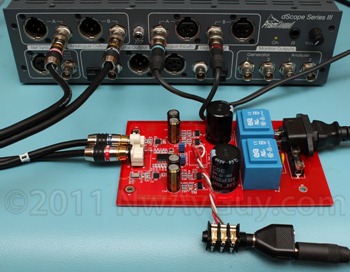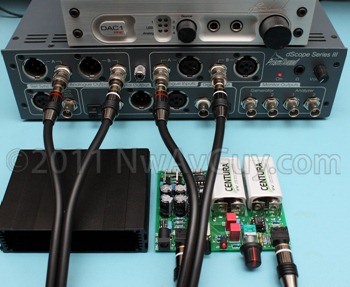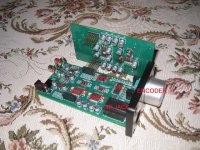My TPA6120 based Per-Anders Sjöström QRV09 headphone amp article is finally published. While it measured very well in most regards (especially for higher impedance loads), it shares some problems areas with the FiiO E9 that also uses the TPA6120.
Reducing the 10 ohm output impedance to near zero is not without some side effects. And both TPA6120 designs have alarming levels of distortion at lower frequencies into low impedance loads (see the graph below). This contradicts the high current capability of the TPA6120. It can deliver a healthy amount of current but it doesn't seem all that happy unless both amps share a very similar design flaw. It's possible paralleling multiple TPA6120s (as JCX has done) would reduce the low impedance distortion but that adds cost and complexity.
So I'm back on the original quest for a relatively simple design with seriously low distortion across the board and a suitably low output impedance. Stay tuned for more soon, but in the meantime, here's the QRV09 article:
NwAvGuy: QRV09 DIY Headphone Amp Review & Measurements


Reducing the 10 ohm output impedance to near zero is not without some side effects. And both TPA6120 designs have alarming levels of distortion at lower frequencies into low impedance loads (see the graph below). This contradicts the high current capability of the TPA6120. It can deliver a healthy amount of current but it doesn't seem all that happy unless both amps share a very similar design flaw. It's possible paralleling multiple TPA6120s (as JCX has done) would reduce the low impedance distortion but that adds cost and complexity.
So I'm back on the original quest for a relatively simple design with seriously low distortion across the board and a suitably low output impedance. Stay tuned for more soon, but in the meantime, here's the QRV09 article:
NwAvGuy: QRV09 DIY Headphone Amp Review & Measurements


It seems NwAvGuy has his desing ready: NwAvGuy: O2 Headphone Amp Great! Eagerly waiting for more details.
As You (all) seem to have good thoughts on headphone amps, i am asking a question.
If I go really mad with pricey resistors for the original reference design from National or any others, which places are important sound wise on an OPAMP based amplifier?
I thought to buy a fancy resistor for the feedback but are there places where I should look for a better sounding resistor (like tantalum ones) too? I know this is an odd question but I want to try it one time and all these parts I have to order from abroad as none is available locally and I want to be sure how many I have to order.
If I go really mad with pricey resistors for the original reference design from National or any others, which places are important sound wise on an OPAMP based amplifier?
I thought to buy a fancy resistor for the feedback but are there places where I should look for a better sounding resistor (like tantalum ones) too? I know this is an odd question but I want to try it one time and all these parts I have to order from abroad as none is available locally and I want to be sure how many I have to order.
First of all, I've rather mute on this thread because of a lack of time. I've had many distractions one of them being the headphone project egallego already mentioned above.
The O2 now has its own official thread here on diyAudio and the third article of the trilogy just went up on my blog (full of typos I'm sure) Those following this thread may find the O2 rather interesting:
The Objective2 (O2) Headphone Amp Project
To answer earfanatic's question I talk about resistors some in the article linked above. Generally it's the feedback resistors for the gain stage and possibly the input bias/network that matters most. But in a low impedance design where the feedback resistors are under 2K or so, I'm not sure expensive parts really help much as the Johnson Noise is already so low it's usually not a problem in a headphone amp. It would be different in perhaps a phono preamp, mic preamp, etc where you have vastly more gain.
And, in my testing (and even on some datasheets) the noise differences between resistors is very much proportional to their value. So as the values get smaller there's less benefit to the more expensive parts.
In SMT resistors, the bigger the better (stay away from the small ones) and never use thick film. Doug Self has shown them to not follow ohms lay very well adding distortion (the spec is called the Voltage Coefficient--how much the resistance changes with the applied voltage). For audio it's not good to have a resistor constantly changing value with the audio signal.
For standard 1/4 and even 1/8 watt sized through hole resistors, however, I'm not sure the differences are that significant in something like the National reference design.

The O2 now has its own official thread here on diyAudio and the third article of the trilogy just went up on my blog (full of typos I'm sure) Those following this thread may find the O2 rather interesting:
The Objective2 (O2) Headphone Amp Project
To answer earfanatic's question I talk about resistors some in the article linked above. Generally it's the feedback resistors for the gain stage and possibly the input bias/network that matters most. But in a low impedance design where the feedback resistors are under 2K or so, I'm not sure expensive parts really help much as the Johnson Noise is already so low it's usually not a problem in a headphone amp. It would be different in perhaps a phono preamp, mic preamp, etc where you have vastly more gain.
And, in my testing (and even on some datasheets) the noise differences between resistors is very much proportional to their value. So as the values get smaller there's less benefit to the more expensive parts.
In SMT resistors, the bigger the better (stay away from the small ones) and never use thick film. Doug Self has shown them to not follow ohms lay very well adding distortion (the spec is called the Voltage Coefficient--how much the resistance changes with the applied voltage). For audio it's not good to have a resistor constantly changing value with the audio signal.
For standard 1/4 and even 1/8 watt sized through hole resistors, however, I'm not sure the differences are that significant in something like the National reference design.

I was just studying it.  He has them here
He has them here
https://docs.google.com/viewer?a=v&...OWJjOC00NmVmLWE0YzQtMDg4ZjQzMjJlMWJl&hl=en_US
Interesting amp! I didn't know that Mouser stocked JRC/NJR parts.
https://docs.google.com/viewer?a=v&...OWJjOC00NmVmLWE0YzQtMDg4ZjQzMjJlMWJl&hl=en_US
Interesting amp! I didn't know that Mouser stocked JRC/NJR parts.
Some have had trouble with the Google Docs link, I'm not sure why. Try:
https://docs.google.com/viewer?a=v&pid=explorer&chrome=true&srcid=0B52Awjeyc5zKNjQyOTlhMjAtZTNmOS00ZTNlLWEyMzgtZTQ0YzUwN2ViOTc4&hl=en_US
https://docs.google.com/viewer?a=v&pid=explorer&chrome=true&srcid=0B52Awjeyc5zKNjQyOTlhMjAtZTNmOS00ZTNlLWEyMzgtZTQ0YzUwN2ViOTc4&hl=en_US
Hi RocketScientist, interesting that you chose the NJM4556 and not the buffer in the title of this thread. Are you trying to make a point that you don't need modern fancy parts or have you compared and prefer the opamp you've chosen.
It would be good to hear your subjective opinion on others
It would be good to hear your subjective opinion on others
If cost is no object, and you're OK with surface mount, I think a good LME49600 design will perform slightly better on a test bench than the NJM4556 design I've published. But, in the real world, I honestly can't find any reason to recommend the LME49600 over the much cheaper, more stable, and more DIY friendly NJM4556 as implemented in the O2.
If someone comes up with some popular headphones I might have missed that are outside the O2's capabilities, that might change things slightly. But, AFAIK, parallel 4556 op amps can match the LME49600 in the real world of driving real world headphones.
A good example is the O2 matching and/or beating the Benchmark DAC1 Pre which uses the BUF634--a very similar part to the LME49600.
If someone comes up with some popular headphones I might have missed that are outside the O2's capabilities, that might change things slightly. But, AFAIK, parallel 4556 op amps can match the LME49600 in the real world of driving real world headphones.
A good example is the O2 matching and/or beating the Benchmark DAC1 Pre which uses the BUF634--a very similar part to the LME49600.
No, I explain why not in section 2-12 in the O2 Design Process article. The LME49600 by itself has no gain. So for low distortion it has to be inside the feedback loop of another amp that does have gain. That's not possible with the O2's topology without adding a third stage. If you want to use the LME49600 I would start with National's reference design and/or The Wire.Can the NJM4556 switched to LME49600 without modification? Except the paralleling of course.
This's my LME49710+LME49600 used +/-9V (converted from +12V)
I try to change LME49710 to metal version on next month.
Thanks
Anadigit
Hi Anadigit!
Do You use digital volume control?
Hi Anadigit!
Do You use digital volume control?
Yes, pga2311 by PIC control.
There're USB NATIVE ASYNCHRONOUS 24/192 input, too
That will be interesting to me.I try to change LME49710 to metal version on next month.
I used the plastic dual 4562NA, the metal can dual 49720HA and two metal can single 49710HA.
Metal dual = a lot better than the plastic dual.
Metal single = even bigger difference to the metal dual.
The plastic and metal dual took three weeks to run in. Sounded thin. The metal single, however, was great straight away. Punchy, great transient response, better tonal balance.
I've not tried the surface mount version.
So will like to find out the result of your comparison.
Another surface mount chip you might like to try is the 49990. Some people are saying they sound better than the 49710.
On the topic of the National design, can anyone guide me as to why I would not want to do the following:
-Move the pot from the input to just prior to the LME49600's (pin 2) with a small cap to take the grit out, and put a 10k cap in the place of the original pot at the input of the LME49720's (pin 3).
The LME49600 is included in the feedback loop of the LME49720 so I'm not sure what is going to happen if I put resistance there. Anybody?
-Move the pot from the input to just prior to the LME49600's (pin 2) with a small cap to take the grit out, and put a 10k cap in the place of the original pot at the input of the LME49720's (pin 3).
The LME49600 is included in the feedback loop of the LME49720 so I'm not sure what is going to happen if I put resistance there. Anybody?
why? just because the O2 has the pot in the middle does not make it a great idea in this case, me i think its asking trouble. have you modelled it?
I haven't modelled it yet, but I'm working on putting it into LT Spice. I'm guessing National considered that already, but I'm not sure.
I figured I'd have a better sonic experience if my input held a consistent 10k resistance which would have me putting the pot elsewhere.
Did anyone try to build this eBay - New & used electronics, cars, apparel, collectibles, sporting goods & more at low prices ? their design used lme49710 + lme49600, or any comment?
- Status
- This old topic is closed. If you want to reopen this topic, contact a moderator using the "Report Post" button.
- Home
- Amplifiers
- Headphone Systems
- National LME49600 Reference Design Project
